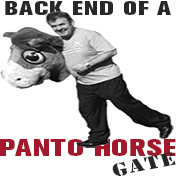 With HorseWorld’s senior management so concerned about public criticism of its decisions – decisions, it should be noted, that have cost the charity a lot of its money, and which currently threaten the livelihoods of dozens of hard-working staff – will it be widening its innovative ‘economic growth through legal threats’ strategy beyond The BRISTOLIAN and a student rag?
With HorseWorld’s senior management so concerned about public criticism of its decisions – decisions, it should be noted, that have cost the charity a lot of its money, and which currently threaten the livelihoods of dozens of hard-working staff – will it be widening its innovative ‘economic growth through legal threats’ strategy beyond The BRISTOLIAN and a student rag?
And if so, where does that leave Rowena Hayward, the GMB union official now representing around half of HorseWorld’s staff, whose letter published in the Western Daily Press on Saturday 15 February contains some stinging implied criticism of how the Pinocchiowen regime has managed the crisis at HorseWorld? Will she too be on the receiving end of a poorly drafted screed from Burges Salmon’s latest work experience? And how about Tim Dixon, the editor of the Bumpkinshire Post?
Will the threats ever end?
Union’s concerns over HorseWorld
The GMB is extremely concerned about the recent announcement from HorseWorld Trust with its intention to make 27* staff redundant out of a total of 56 workers. It does seem “odd” when it is closing its visitor centre, getting rid of two of its marketing, media staff and volunteer co-ordinator which actually enable the public to come along and help boost the trust’s coffers, to promote the work of the trust and ensure a proper volunteer structure is in place.
The trust has been running at a loss over the last five years or so leading to a net loss over that period of £2 million. Surely this can’t be down to bad management as, according to HorseWorld’s own website there are a number of very successful businessmen on the trust’s board.
The questions the GMB are asking include:
- Why were HorseWorld accounts in deficit over the last five years?
- What financial recovery plan is in place during the past five years?
- How much is paid to the chief executive and the senior management team? Many of the 24 workers facing redundancy are on the minimum wage or just above
- How much is the trust likely to save by making staff redundant, closing the visitor centre and leaving the buildings boarded up to go into disrepair?
- The visitor accounts used to be kept separate. In 2012 this was changed and all areas of HorseWorld’s accounts were put together – why?
- How does senior management and trustees propose to recoup income lost from the closures?
- HorseWorld claims the only reason for the redundancy of just under 50 per cent of its staff is the rejection by Bath and North East Council of its plan to build houses on the existing visitor centre site and to seek planning permission to build a bigger visitor centre on green belt land. Yet as the charity has lost some £2 million in the last five years, the financial problems cannot be attributed solely to one decision by the local council.
- If the board of trustees and the managing director are unable to run the trust with the current financial constraints, how will they be able to manage it in the future?
- The GMB is unsure if some of the legacies left to the trust stipulate the land currently used by the visitor centred was bequeathed to the ‘horses’ rather than for domestic property usage.
The GMB is urging the public and supporters of HorseWorld to ask these questions and more to ascertain why 24 dedicated workers are being forced into redundancy.
The GMB is calling on the board of trustees to call a halt to this process until these questions are answered.
Rowena Hayward
Membership development officer, GMB

